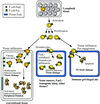Fas-ligand: privilege and peril
- PMID: 9177153
- PMCID: PMC33671
- DOI: 10.1073/pnas.94.12.5986
Fas-ligand: privilege and peril
Figures


Comment on
-
Polymorphism of murine Fas ligand that affects the biological activity.Proc Natl Acad Sci U S A. 1997 Apr 15;94(8):3914-9. doi: 10.1073/pnas.94.8.3914. Proc Natl Acad Sci U S A. 1997. PMID: 9108079 Free PMC article.
-
Transgenic expression of CD95 ligand on islet beta cells induces a granulocytic infiltration but does not confer immune privilege upon islet allografts.Proc Natl Acad Sci U S A. 1997 Apr 15;94(8):3943-7. doi: 10.1073/pnas.94.8.3943. Proc Natl Acad Sci U S A. 1997. PMID: 9108084 Free PMC article.
References
Publication types
MeSH terms
Substances
LinkOut - more resources
Full Text Sources
Other Literature Sources
Research Materials
Miscellaneous

